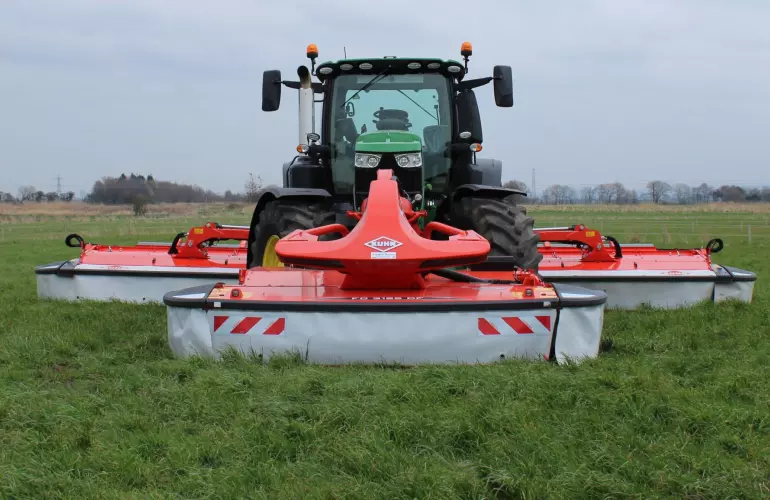
Fearns Farm is a thriving farming business near Ormskirk, Lancashire, that is taking forage production to a new level. Rob Wrennall’s’ family decided to move away from dairying to focus on creating forage for the equestrian and pet market. With 450 acres, he has invested in a significant amount of machinery to make the most of the forage including a new KUHN mower and baler.

“Traditionally we would take two cuts, with the first being the premium product for feeding horses. However, we installed a continual flow drier in 2021 which has enabled us to take up to eight cuts because we can prepare the product much more quickly,” he explains.
The farm used a KUHN double mower for taking cuts but since the number of cuts have increased, Mr Wrennall has invested in the new KUHN 3125 front mower and dual FC 9330 RA rear mowers. The combination enables him to mow, condition and group in one pass. It has also seen the speed he can cut rise to 16km/h using his 250 horsepower John Deere 6250R.

“It has improved and sped up the process immeasurably. I can control everything using the tractor’s ISOBUS and, whilst the mower is heavy, it is very easy to operate with all the controls, including the merger belts, on one screen. We follow on with a New Holland forager to bring the cut back to the drier in a nice fluffy form. We tried a forage wagon, but it caused the grass to ball together which meant it didn’t dry evenly. This new combination is a perfect solution for our system.”
The forager has been adapted to the task by removing half of the 16 knives in the drum.
“We have found that this keeps the grass fluffy when it is loaded into the trailer.” The outcome is the 75% moisture grass can be delivered directly to the drier which will process it to below 16% moisture in just one hour. “It is working really well, and every piece of machinery is exactly what is needed to make the process as efficient as possible.”
The weather windows in the northwest have often compromised forage production, which was a significant factor in drier investment. Four days in the field have been cut to just one and there is no longer the threat of spores and mould developing because the drier removes this before it has chance to build up.
The business also wanted to increase the amount of bagged forage it sells through a retail shop on the farm.
“Demand for quality bagged, green forage has increased. The equestrian market prefers the colour, and the drier has enabled us to bag 200 acres of forage a year. However, there is still demand for traditional haylage because it is more economical to buy in bulk for the larger liveries.”
The remaining 250 acres are baled using a KUHN FBP 3135 combination baler which is also a new addition to the farm. “There is still high demand for traditional bales and so we wanted to improve the efficiency of our baling by updating to the 3135. It makes a nice tight, uniform bale which has improved the overall quality and also means we can stack them more easily,”

Before baling he uses a 13 metre KUHN tedder to shake out the swath. This is repeated four to five times before following with the baler.
“The quality is second to none. We previously used a square baler, but we couldn’t get enough weight in the bales. The first, round, combi baler we used wasn’t giving us the quality we needed so we switched to the KUHN and now we have a much more consistent bale with less air.”
KUHN’s INTELLIWRAP system uses a 750mm film wrap to reduce costs and save time. The 3135 also creates a tighter, more compact bale using a 3D wrapping system that gives the bale better protection around the circumference. This oxygen barrier helps improve bale quality, resulting in a bale with a higher nutritional value. The shape of the bale has also been adjusted to make it easier to handle and store.
To achieve the 6 to 8 cuts he makes in a year, Mr Wrennall has chosen a timothy and rye mixture to combine the stalky rye with the softness of the timothy. The grass is tested and first cuts average 28.5% water soluble sugars.
“When we only took two cuts we would see the sugars of the second cut drop significantly to around 16% which, along with the darker colour, made it less appealing to the equestrian market. We have improved the overall sugar values and using the drier we are also making a higher quality end product.”

He reseeds the grass leys every four to five years to maximise the fibre in the fast-growing rye. Working with local agronomist Tom Smith from County Crops, he has also chosen to test his soil more regularly to better understand the level of inputs that will be needed to stimulate growth.
“After every cut we add potash which has improved the balance of the soil. We also use a subsoiler to lift the sward which stimulates growth.”
The farm now has a thriving retail business selling forage, bedding, and pet products, along with clothing and equipment.
“When my father sold the dairy cows we didn’t anticipate moving into the retail the way we have, but it has been a good move for the farm and the family. We invested in the pre-pack machine 15 years ago and the drier has helped us to increase our retail product significantly. I think we have the balance of traditional and retail supply right now, and it is a sustainable business that we all have a part in,” he concludes.
